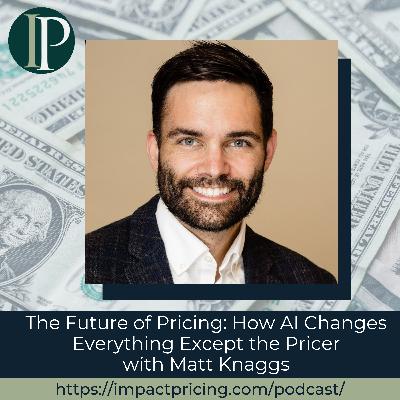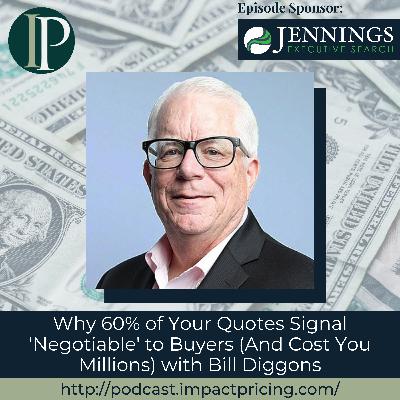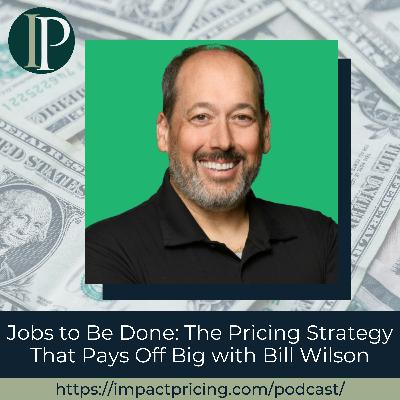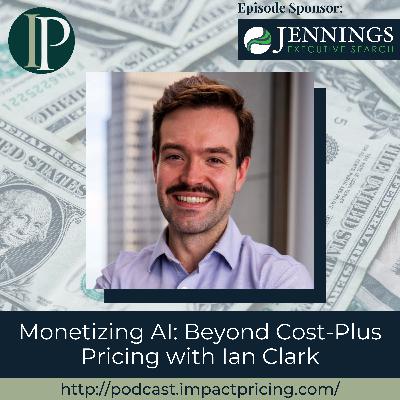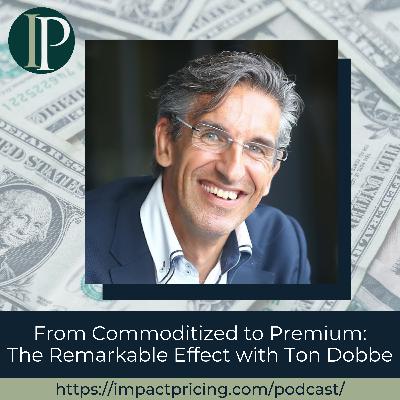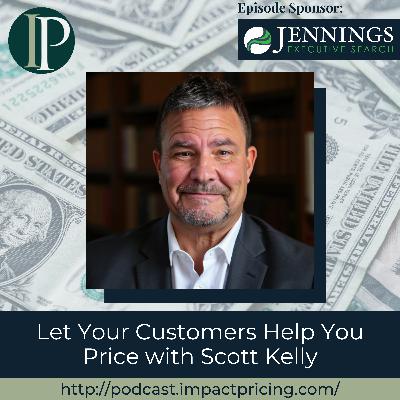Discover Impact Pricing
Impact Pricing

Impact Pricing
Author: Mark Stiving, Ph.D.
Subscribed: 96Played: 4,851Subscribe
Share
© Impact Pricing 2022
Description
The Impact Pricing Podcast will help you win more business at higher prices by teaching you about pricing and value.
Once you understand how your buyers perceive the value of your product, you can build, market and sell products that win at higher prices.
Pricing is really about creating, communicating and capturing value.
Once you understand how your buyers perceive the value of your product, you can build, market and sell products that win at higher prices.
Pricing is really about creating, communicating and capturing value.
742 Episodes
Reverse
Matt Knaggs, Senior Business Value Lead at Zilliant, brings a decade of pricing insight shaped by an unexpected leap from industrial safety into commercial excellence. Known for blending analytics, AI, and practical sales enablement, he now helps B2B companies make smarter, more confident pricing decisions by pairing data science with human judgment. In this episode, Matt and Mark dive straight into the real-world intersection of pricing and AI, where deterministic models still set prices, GenAI fills in missing context, and messy CRM data finally becomes usable. Matt shares how he built a custom GPT that builds other GPTs, why "pricer in the loop" is essential, and how AI can elevate pricing teams without replacing them. They unpack the future of pricing, the danger of outsourcing expertise, and why curiosity beats perfection in an AI-driven world. Why You Have to Check Out Today's Episode: Learn how AI can enhance pricing (without setting prices for you) - including specific use cases where GenAI adds context, fills data gaps, and boosts pricer effectiveness. Discover the "Pricer in the Loop" model and why Matt believes humans will remain essential for trust, validation, nuance, and internal adoption. See how to use AI as a thought partner - to generate buyer problems, value drivers, competitive alternatives, and messaging frameworks that accelerate value-based pricing. "Don't hide from all of the advancements in AI. It can be scary and intimidating, but try what you can. AI won't tattle on you for asking dumb questions." - Matt Knaggs Topics Covered: 03:30 – How Matt Went From Safety to Pricing—and Why the Discipline Hooked Him 04:22 – The Reality of AI in Pricing: What Matt Sees Working (and Failing) Inside Companies 11:58 – Matt Reacts to Mark's Approach: Using AI to Map Buyer Context 15:34 – When a Pricing Expert Builds AI That Builds AI: Matt's Custom GPT Story 19:01– The Messy Data Problem Every Pricer Knows… and How Matt Uses AI to Fix It 24:09– Matt's Honest Take on the Future: Why AI Won't Replace Pricers Anytime Soon 27:34 – The Threat to Expertise: Matt and Mark Explore What Happens When People Outsource Thinking 31:53 – What AI Can Do for Pricing Strategy (If You Use It Intelligently) 33:15 – Matt's Final Challenge to Pricers Key Takeaways: "AI is probabilistic, not deterministic. You can give it the same inputs and get different outputs. That's why I'm not ready for GenAI to set prices." - Matt Knaggs "You don't need to learn AI to protect your job. But if you ignore it, the person who learns how to use AI might take your job." - Matt Knaggs "The future pricer isn't replaced—it's the translator. The one who explains the 'why' behind what AI suggests." - Matt Knaggs "You can't outsource judgment. You need the pricer in the loop to validate hallucinations, nuance, and context." - Matt Knaggs "AI can scan markets, pull competitor moves, and hand-wave at things you should consider—things deterministic models miss." - Matt Knaggs People & Resources Mentioned: Zilliant: Pricing optimization & management platform where Matt leads value initiatives Stephan Liozu: Pricing author referenced for value-based pricing frameworks Salesforce + OpenAI / Claude Connectors: For CRM automation Connect with Matt Knaggs: LinkedIn: https://www.linkedin.com/in/matthewknaggs/ Connect with Mark Stiving: LinkedIn: linkedin.com/in/stiving Email: mark@impactpricing.com
This is an Impact Pricing Blog published on September 8, 2025, turned into an audio podcast so you can listen on the go. Read Full Article Here: https://impactpricing.com/blog/pricing-ai-the-value-of-packaging/ If you have any feedback, definitely send it. You can reach us at mark@impactpricing.com. Now, go make an impact. Connect with Mark Stiving: Email: mark@impactpricing.com LinkedIn: https://www.linkedin.com/in/stiving/
Bill Diggons, managing partner at Qittitut Consulting (yes, named after a fast-growing, healthy Inuit bear), shares 24 years of pricing wisdom earned across 182 projects in 57 countries. A disciple of pricing legend Tom Nagle and former oil industry marketer at Schlumberger and Halliburton, Bill reveals why single-column bids are leaving 3-5 margin points on the table and how tiering transforms B2B pricing. From Wagyu beef pricing psychology to semiconductor de-specification strategies, Bill and Mark debate whether prices should be easy or hard to compare, why "Boss Hog" beats techno-nerd names, and the counterintuitive power of ending prices in odd numbers instead of zeros. Plus, why Bill charges $5,000 extra just to read client contracts. Why you have to check out today's podcast: Discover why tiering consistently delivers 3-5 margin points minimum—and how three-column bids with strategic naming force buyers to make trade-offs instead of price comparisons. Learn the "no zeros" pricing rule that generated $8 million in three months by making prices look carefully calculated rather than negotiable. Master the art of non-compliant RFP responses with alternatives that disrupt tender processes and win on value instead of lowest price. "Not profound, but no zeros on the quote. It's so often that we can get half a margin point just out of stuff like that. And then beyond that, try some naming and tiering because it's going to work for you." – Bill Diggons Topics Covered: 02:09 - The Qittitut Origin Story: Why a Dancing Bear Beat "Bill & Bob's Consulting". 05:39 - What is Tiering? Moving Beyond Single-Column Bids. 10:07 - The Restaurant Menu Masterclass and Boss Hog's Emotional Appeal - How to Decide What Features Go in What Tiers. 19:02 - Responding to RFPs with Tiered Alternatives and Non-Compliant Bids. 20:02 - The Power of "Networking Best Practices Meeting" vs. "Presentation". 26:23 - Final Advice: No Zeros on the Quote (And Why It Generated $8 Million). 28:12 - Contacting Bill and Why He Charges $5,000 to Read Contracts. Key Takeaways: "Tiering to me is having at least a three-column bid, naming the columns, and then having some names on the products or services to imply added value. Whenever we've introduced this, it always results in three to five margin points minimum." - Bill Diggons "I demand the right to segment that price to the outcome, the value the buyer gets. Even though the variable cost of the motor is identical, I want to be able to sell it at an economy price in a benign environment and at a premium price in an extreme environment because I put billions of dollars into creating this thing." - Bill Diggons People / Resources Mentioned: Tom Nagle: Author of "Strategy and Tactics of Pricing" - pricing authority who transformed Bill's approach in oil and gas. Schlumberger: Oil company where Bill worked in marketing. Halliburton: Oil company in Bill's background. QSales: Where Bill was practice leader for 20 years. A.T. Kearney, McKinsey, Deloitte: Consulting firms mentioned in the RFP rejection story where Bill's price was "too low". Starbucks: Referenced for tall, grande, venti tiering strategy. iPhone/Apple: Used as two examples - 99-cent pricing psychology AND customers not comparing to Huawei when upgrading. Huawei: Mentioned as iPhone competitor that iPhone users ignore when upgrading. Connect with Bill Diggons: Company: https://www.qittitut.com/ Linkedin: https://www.linkedin.com/in/billdiggons/ Email: bill@qittitut.com Connect with Mark Stiving: LinkedIn: https://www.linkedin.com/in/stiving/ Email: mark@impactpricing.com
This is an Impact Pricing Blog published on September 1, 2025, turned into an audio podcast so you can listen on the go. Read Full Article Here: https://impactpricing.com/blog/packaging-ai-structuring-features-and-placing-ai-in-offers/ If you have any feedback, definitely send it. You can reach us at mark@impactpricing.com. Now, go make an impact. Connect with Mark Stiving: Email: mark@impactpricing.com LinkedIn: https://www.linkedin.com/in/stiving/
Sarah Williams, founder and CEO of Leading Culture and former director at GAP Consulting for 23 years, brings her accounting background and business growth strategy expertise to a spirited debate about ROI, value-based pricing, and why companies leave money on the table. From her home in New Zealand (Mark's second favorite country), Sarah challenges conventional pricing wisdom—arguing that ROI applies to both B2B and B2C, that we should ignore competitors when determining value, and that the antidote to the curse of knowledge is thinking with a beginner's mind. Mark pushes back on opportunity costs, explains why competitor pricing matters, and uses everything from vests to Louis Vuitton handbags to make his points in this engaging conversation about helping customers understand the true value of what they're buying. Why You Have to Check Out Today's Podcast: Understand why teaching customers to think in ROI is the fastest way to eliminate buyer's remorse, increase prices, and differentiate from competitors who focus on features. Discover the beginner's mind approach that prevents the #1 mistake pricing experts make—assuming customers know what seems "obvious" to you. Master vulnerability-based trust by inviting customers to ask questions without fear—the counterintuitive sales technique that accelerates deals faster than "looking professional". "Think in terms of value from the customer's perspective." – Sarah Williams Topics Covered: 03:01 - Why ROI Should Be Everyone's Decision-Making Framework 06:10 - Helping Customers Think in ROI Terms: Your Job as the Provider 08:12 - Utility in Economics: The B2C Alternative to Monetary ROI 20:00 - The Opportunity Cost Debate: Pricing vs. Budgeting Decisions 25:19 - Differentiation Value: Starting with Competitor's Price, Then Adding 27:57 - Louis Vuitton vs. $40 Handbags: Conspicuous Consumption and What People Really Buy 32:31 - Starting with a Blank Slate: Thinking Myopically About Customer Value 35:32 - Final Advice: Think in Terms of Value from the Customer's Perspective Key Takeaways: ROI on its own can be a decision-making framework. From the point of view of maybe even making a personal decision, I can think about, well, what's the return on investment? And that might even be an investment of my time." - Sarah Williams "We're doing our customers a disservice if we're not helping them to think in terms of ROI. Like, what really am I getting? Because buyer's remorse is really, really prevalent. People make split-second decisions now and then live to regret it 24 hours later." - Sarah Williams "In economics, there's this concept called utility, right? So, I think in terms of when you're thinking B2C, now you're shifting the conversation a little bit more towards the utility angle in economics." - Sarah Williams People / Resources Mentioned: Jim Collins: Author of "Good to Great" Chip and Dan Heath: Authors of "Made to Stick" and the concept of the curse of knowledge Patrick Lencioni: Leadership expert who popularized vulnerability-based trust and predictive trust concepts GAP Consulting: Where Sarah served as director for 23 years Complete Learning Solutions: Where Sarah was Chief Inspiration Officer Louis Vuitton: Used as example of luxury pricing vs. commodity pricing iPhone: Example of blue ocean differentiation where customers don't compare competitor prices Huawei: Mentioned as iPhone alternative that iPhone users don't consider when upgrading Connect with Sarah Williams: Email: sarah@leadingculture.co.nz Website: https://www.leadingculture.co.nz/home AI Summit Link: https://www.leadingculture.co.nz/ai-summit-registration-page Connect with Mark Stiving: LinkedIn: https://www.linkedin.com/in/stiving/ Email: mark@impactpricing.com
This is an Impact Pricing Blog published on August 25, 2025, turned into an audio podcast so you can listen on the go. Read Full Article Here: https://impactpricing.com/blog/pricing-ai-market-segmentation-matters/ If you have any feedback, definitely send it. You can reach us at mark@impactpricing.com. Now, go make an impact. Connect with Mark Stiving: Email: mark@impactpricing.com LinkedIn: https://www.linkedin.com/in/stiving/
Lindsay Maurer is Pricing Intervention Manager at BP. With 14 years of experience in product management and pricing, she reveals how she achieved a 13% profit gain despite a 16% revenue drop, and why she believes "the dumbest guy in the market sets the price." In this episode, Lindsay and Mark Stiving discuss regional pricing strategies, ethical competitive intelligence, and the power of price signals in the market. They explore what defines a pricing leader versus a follower, why clean data matters more than fancy tools, and why AI can't fix bad pricing fundamentals. Whether you work in pricing, lead a team, or simply want to understand how pricing shapes business strategy, this episode offers practical, real-world insights you can use right away. Why You Have to Check Out Today's Podcast: Learn how to build regional pricing strategies that adapt to local competition and customer behavior. Discover smart, ethical ways to track competitors using tools like Circana data and web scraping. Understand why clean data and efficient processes matter more than any pricing technology. "It doesn't matter how much technology you throw at bad data — it's not going to fix your pricing strategy." – Lindsay Maurer Topics Covered: 02:50 - Getting into Pricing: How Lindsay's career began and what got her hooked on pricing strategy. 06:10 - Inside the Role: What a Pricing Intervention Manager does - from fixing revenue leaks to supporting teams across the Americas. 12:15 - Market Dynamics: Why "the dumbest guy in the market sets the price" and how smart companies protect their margins. 15:08 - Retail Pricing: How retailers test price floors and ceilings, monitor competitors, and manage customer perceptions. 17:31 - Price Leadership: What makes a company a price leader versus a follower, and how market factors like tariffs shape decisions. 20:17 - Competitor Insights: How often to track prices in different industries and how to ethically gather market data. 25:01 - Strengthening Pricing Teams: Why efficient tools, clean data, and solid processes matter more than fancy systems. 28:25 - AI in Pricing: Where AI fits today, what it can and can't do, and how to use it for smarter market insights. 29:57 - Pricing Community: Lindsay's call for collaboration - connecting with other pricing professionals and sharing tools. Key Takeaways: "The dumbest guy in the market sets the price. If you have someone that has products that they can go and sell for half the price of yours, well, you're also taking out half the price of everyone's margin, but also your own." - Lindsay Maurer "Make sure you've got great information coming in. Make sure that you're doing anything you can do with it as efficiently as possible so that when you do get those quotes and you do get those quick turnaround requests for sales that you can price quickly and you don't lose business due to inefficiency." - Lindsay Maurer People / Resources Mentioned: Al Beck: Al Beck: Pricing Director at Standard Motor Products https://www.linkedin.com/in/alexanderkbeck/ Circana (formerly NPD): https://www.circana.com Ficstar: https://www.ficstar.com/ Import.io: https://www.import.io/ SVP Recruiting: Organizer of Pricing Week conference https://svpricing.com/pricing-week Connect with Lindsay Maurer: Website: https://www.bp.com/ LinkedIn: https://www.linkedin.com/in/lindsaymaurer/ Connect with Mark Stiving: LinkedIn: https://www.linkedin.com/in/stiving/ Email: mark@impactpricing.com
This is an Impact Pricing Blog published on August 18, 2025, turned into an audio podcast so you can listen on the go. Read Full Article Here: https://impactpricing.com/blog/pricing-ai-are-you-selling-a-platform-or-a-solution/ If you have any feedback, definitely send it. You can reach us at mark@impactpricing.com. Now, go make an impact. Connect with Mark Stiving: Email: mark@impactpricing.com LinkedIn: https://www.linkedin.com/in/stiving/
Bill Wilson, CEO and founder of Pace Pricing and official pricing advisor for the government of New Zealand, takes Mark on a deep dive into Jobs to be Done methodology and its connection to value-based pricing. From his origins as a software developer building productized services to coaching hundreds of companies through SaaS Academy, Bill reveals why pricing isn't just about the number—it's about understanding the progress customers are trying to make. In this episode, Mark and Bill dive into why the Jobs to Be Done framework offers a more effective lens than traditional problem-and-results approaches, leading to insights about value realization, emotional jobs, and why the biggest pricing advice might be the simplest: just raise your prices. Why You Have to Check Out Today's Podcast: Learn the critical role of value realization and how to effectively package products to help customers achieve desired outcomes quickly and sustainably. Understand the Jobs to Be Done framework, how it differs from traditional problem-solving approaches, and why it's vital for grasping true customer motivations. Discover practical pricing strategies, including overcoming fears around raising prices and how thoughtful price increases positively impact a company's bottom line. "Without being too on the nose about it, you probably should raise your prices." – Bill Wilson Topics Covered: 01:32 - Bill's journey from technical founder in 2007 to productizing services, escaping hourly billing, and discovering that pricing is everyone's delicate secret. 06:59 - The Product-Pricing-Positioning Triangle Why these three cannot be separated: value delivery (product), value perception (positioning), and value capture (pricing). 09:33 - What is Jobs to be Done? Bill's definition: statements describing the progress customers are trying to make, with specific ways to measure that value. 14:17 - The Trigger Moment: Status Quo Change Why the sandwich shop example illustrates how triggers create jobs people are willing to pay to solve, unlike generic problems. 20:11 - Context-Driven Pricing Meets Jobs to be Done Mark's framework of foundational problems, problem scope, and situational context—and how it maps to Bill's JTBD structure. 21:56 - System 1 vs. System 2: Emotion vs. Value Separating intuitive, emotional buying (System 1) from deliberative value calculation (System 2)—and why B2B sellers must address both. 26:39 - The Three Phases of Value Value perception (positioning), value realization (first aha moment), and value adoption (features driving continuous use). 30:08 - The Product-Pricing-Positioning Connection in Practice: Why Bill sometimes produces product requirements documents during pricing engagements—because time-to-value affects pricing success. 30:28 - Final Advice: Raise Your Prices The simplest, most powerful advice that everyone fears—and why money from price increases falls directly to the bottom line. Key Takeaways: "A job to be done inherently has monetization built into it because there are a lot of problems that I'm not willing to pay to be solved. But a job in and of itself is something I'm actively trying to achieve." - Bill Wilson "Recurring revenue lives in value adoption, not in value realization. I can get anybody to realize value pretty quickly and they'll never buy my product more than once." - Bill Wilson "Everybody's scared to death to raise their prices. But if you haven't raised your prices in a couple of years, you're probably safe to raise your prices. And all that money that you raise it by, whatever percentage that is, is going to fall directly to the bottom line." - Bill Wilson People / Resources Mentioned: April Dunford: Positioning expert, author of "Obviously Awesome" and "Sales Pitch" Anthony Ulwick: Outcome-Driven Innovation approach to Jobs to be Done Clayton Christensen: Jobs to be Done theory pioneer Danny Kahneman: System 1 and System 2 thinking framework SaaS Academy: Where Bill coaches companies on pricing Volta: Coaching organization Bill works with Connect with Bill Wilson: Pace Pricing: https://www.pacepricing.com/ LinkedIn: https://www.linkedin.com/in/wdrwilson/ Connect with Mark Stiving: LinkedIn: https://www.linkedin.com/in/stiving/ Email: mark@impactpricing.com
This is an Impact Pricing Blog published on August 11, 2025, turned into an audio podcast so you can listen on the go. Read Full Article Here: https://impactpricing.com/blog/pricing-ai-do-costs-finally-matter-in-pricing/ If you have any feedback, definitely send it. You can reach us at mark@impactpricing.com. Now, go make an impact. Connect with Mark Stiving: Email: mark@impactpricing.com LinkedIn: https://www.linkedin.com/in/stiving/
Emanuel Martonca, founder of Soft Fight, reveals how agentic AI is solving one of the biggest challenges in IT services: coordinating pricing decisions across hundreds of people in decentralized organizations. After his career journey from product management to sales management to discovering pricing at a Simon Kucher workshop, Emanuel shares how his bootstrapped company evolved from traditional consulting to building AI-powered pricing agents that act as an ever-present pricing manager- coaching teams, improving proposals, and recommending pricing models without sending a single byte of data outside the client's infrastructure. In this episode, learn why AI should augment rather than replace pricing teams, why deterministic calculations still matter, and how to quantify value in IT services without universal quality standards. Why You Have to Check Out Today's Podcast: Discover how AI solves coordination problems in large IT services companies where hundreds of people make pricing decisions without pricing expertise. Learn why AI should augment pricing teams, not replace them, and why deterministic calculations still matter more than probabilistic AI outputs. Understand how to quantify value in IT services using measurable quality attributes instead of universally accepted standards. "Pricing is leverage. It allows you to have an impact with very few actions, with little effort." – Emanuel Martonca Topics Covered: 01:32 -Emanuel's transformational discovery of pricing at a Belgian retail bank workshop that revealed a world he didn't know existed—launching 18 years of pricing-focused work. 02:37 - Why pricing is the ultimate leverage tool, especially in B2B tech where "it's just communication"—what you write in Excel, on websites, and in proposals. 03:28 - How the pandemic transformed Emanuel from a globe-trotting sales manager into a pricing consultant, then bootstrapped Soft Fight to solve the value extraction gap in tech companies. 04:41 - How large IT companies lose money when hundreds of non-experts across five functions (finance, marketing, sales, delivery, executives) make pricing decisions on every custom project. 06:59 - The evolution from deterministic SaaS pricing rules to AI-augmented agents installed in client infrastructure—solving pricing problems in hours instead of years without sending data externally. 08:00 - Why new deals lack technical depth and renewals lack value articulation—and how AI coordinates knowledge without restructuring organizations. 11:00 - Eight AI agents (four for understanding, four for justifying) with access to all systems but zero external communication—no security or privacy risks. 13:00 - All pricing calculations remain deterministic because AI makes too many mistakes—it's used only for reading RFPs, emails, and meeting notes to improve value communication. 14:17 - How AI acts as a coach recommending pricing models with ready-made arguments, eliminating months of change management—with email as the main interface. 16:17 - Why determining "how long will this take?" is unpredictable and varies by person and timing—and how AI solves the costliest unknown in custom projects. 18:00 - Mark's perspective on why costs matter less than value, and why companies avoid alternative pricing models despite knowing hourly billing hurts both sides. 21:00 - When AI tools cut development time, hourly pricing becomes self-defeating: "You're cutting your own revenue"—forcing the industry to finally sell value, not time. 21:56 - Starting with measurable quality attributes on invented scales that competitors can't compare—getting 80% of the way just by having the quantification discussion. 23:00 - Mark's framework for B2B value and why results translate to economic impact through customer KPIs like reduced complaints, not abstract "quality" metrics. 25:00 - Unlike automotive suppliers with nanometer specs, IT services vendors can define their own quality metrics—putting them two steps ahead of alternatives. 26:00 - The necessity of industry knowledge for value conversations (increase revenue, reduce costs, mitigate risk) and how AI enables understanding of new sectors that would've taken years. 27:30 - Final Advice: AI as Your Pricing Force Multiplier Using AI for research, analysis, and domain understanding when teams are too small or mandates unclear—plus how to connect with Emanuel on LinkedIn. Key Takeaways: "AI is a huge multiplier for pricing experts—not for calculating prices, I agree with you on that, it's not there yet. But for everything else around pricing, whether we want to call it product management, analysis, or research, it can help us overcome typical challenges." - Emanuel Martonca "Pricing is a change management problem. It can be done, it'll take months, sometimes years, and they have to experiment and they have to make mistakes." - Emanuel Martonca Resources Mentioned: Simon-Kucher: https://www.simon-kucher.com/en Connect with Emanuel Martonca: Website: https://www.softfight.com/ LinkedIn: https://www.linkedin.com/in/emartonca/ Connect with Mark Stiving: LinkedIn: https://www.linkedin.com/in/stiving/ Email: mark@impactpricing.com
This is an Impact Pricing Blog published on August 4, 2025, turned into an audio podcast so you can listen on the go. Read Full Article Here: https://impactpricing.com/blog/pricing-ai-buyers-buy-inherent-and-relative-value/ If you have any feedback, definitely send it. You can reach us at mark@impactpricing.com. Now, go make an impact. Connect with Mark Stiving: Email: mark@impactpricing.com LinkedIn: https://www.linkedin.com/in/stiving/
Whether you've been with us since the beginning or you just discovered Impact Pricing last week, this episode is for you. If you're one of our longtime listeners, you know Mark's voice, you've heard his insights, and maybe you've even implemented some of his strategies in your own business. But have you ever wondered what drives him to keep showing up week after week, year after year? If you're new here, welcome. You're about to meet the person behind the podcast—not just as a pricing expert, but as someone who genuinely loves teaching and believes that understanding value can transform your business and your career. Mark Stiving is the host of Impact Pricing and founder of Impact Pricing LLC. But before he was a pricing expert, he was a teacher—of scuba diving, kayaking, and marketing. That passion for helping people learn never left him. Even after retiring in 2019, Mark couldn't stop sharing what he knows about pricing and value. In this heartfelt solo episode, Mark pulls back the curtain on his journey. He shares why he chose to dedicate his post-retirement life to pricing education, what keeps him energized after blogging every week since 2010, and the two critical topics that consume his attention right now. This isn't just another pricing lesson—it's an invitation to understand the "why" behind everything we do here at Impact Pricing. For our loyal listeners: Thank you for being part of this community. This episode is Mark's way of reconnecting with you and reaffirming his commitment to your success. For our new listeners: This is the perfect place to start. You'll understand not just what we teach, but why it matters so deeply to the person teaching it. Why you have to check out today's podcast: Discover why teaching and sharing pricing knowledge became Mark's post-retirement mission and driving passion. Learn about the two critical topics dominating modern pricing strategy: AI pricing and context-driven pricing. Understand how value impacts decisions across sales, marketing, product development, and packaging—not just pricing. "Probably my single most favorite thing is when I share something with someone and it has an impact on their life. I absolutely love that." - Mark Stiving Topics Covered: 00:30 - Mark's Retirement and Continued Mission. Why Mark retired in 2019 but couldn't stop sharing pricing knowledge, and how his blogging streak since 2010 kept him connected to his passion. 01:15 - The Joy of Teaching. Mark's history as an instructor across multiple disciplines—from scuba diving and kayaking to university-level marketing—and why teaching is his core passion. 02:00 - The Pricing Knowledge Gap. Why pricing and value are critical business topics that remain poorly understood, and Mark's mission to change that. 02:45 - Working with Different Organizations. How Mark's work differs between large enterprises (focusing on sales teams) versus small and mid-sized businesses (focusing on executive teams). 03:30 - Two Current Focus Areas. Deep dive into Mark's concentration on AI pricing and context-driven pricing, including the concept of value architecture. 04:45 - Context-Driven Pricing Framework. How buying contexts differ for every purchase and how companies can structure their product portfolios to deliver and capture more value. Key Takeaways: "Pricing and value are such important topics in all of business and so few people understand it. And that's almost my mission now is just to see how many people I can get to have a better understanding." - Mark Stiving "All buying is contextual. Every purchase that's made is made in a different way than any other purchase has ever been made." - Mark Stiving "When we start thinking through context-driven pricing, that drives me to something I call a value architecture, which is how do you structure the way you think, the way you built your product portfolio, the way you have packaged your greatest features?" - Mark Stiving Resources Mentioned: Impact Pricing Blog (since 2010): https://impactpricing.com/blog/ Mark's Substack newsletter Impact Pricing monthly newsletter Connect with Mark Stiving: LinkedIn: https://www.linkedin.com/in/stiving/ Email: mark@impactpricing.com Website: https://impactpricing.com
This is an Impact Pricing Blog published on July 28, 2025, turned into an audio podcast so you can listen on the go. Read Full Article Here: https://impactpricing.com/blog/pricing-ai-a-practical-guide-for-a-hype-filled-world/ If you have any feedback, definitely send it. You can reach us at mark@impactpricing.com. Now, go make an impact. Connect with Mark Stiving: Email: mark@impactpricing.com LinkedIn: https://www.linkedin.com/in/stiving/
Ryan Doran is a Partner in Lead Creative and Head of UI/UX for Turkois, with over 17 years of experience in monetization strategy, payments, and scaling technology businesses. Danny Smith is a Solution Architect at Stripe, working on AI-driven commerce innovations and partnering with AWS. In this episode, Ryan and Danny explore the critical intersection of pricing strategy and payment infrastructure, discussing how AI is transforming both the mechanics of pricing implementation and the challenge of pricing AI products themselves. Why you have to check out today's podcast: Understand the difference between billing systems and payment systems and how they work together. Learn why flexible technical infrastructure is essential for modern pricing strategies. Discover how AI is enabling hyper-personalized shopping experiences with built-in guardrails. "Your pricing strategy is only as good as the background tech that you have to operationalize it. If you have a legacy monolithic stack and you can come up with these great strategies, but it takes you six months to implement that strategy, then you've probably been left behind already." – Danny Smith Topics Covered: 02:15 - How Ryan got into pricing through product development and payment flows. 04:30 - Danny's journey from cloud architecture to payments infrastructure. 06:45 - The difference between billing systems and payment systems. 10:20 - Why new billing companies continue to emerge despite established players. 14:15 - How AI is accelerating data utilization in pricing decisions. 17:30 - The dual challenge: using AI for pricing vs. pricing AI products. 19:45 - Hyper-personalized shopping with AI agents and built-in guardrails. 23:10 - The ethical concerns of "sleazy price segmentation" and AI pricing. 28:40 - Agent-to-agent negotiations and policy engines. 31:20 - How AI products are changing pricing models: tokens, credits, and hybrid approaches. 35:15 - Creating "action units" to translate technical complexity into business value. Key Takeaways: "Data is basically the new margin. What you can do with it is only gaining in value." - Ryan Doran "We've implemented API level technology that will create a budget... and it will create a virtual debit card on the backend for that exact amount, tied to today as an expiration date, tied to that particular transaction." - Danny Smith People / Resources Mentioned: Turkois: https://turkois.io/ Vanilla POS: https://vanillapos.io/ Stripe: https://stripe.com Perplexity: https://www.perplexity.ai/ OpenAI: https://openai.com/ Chargebee, Chargeify, Zora: Alternative billing platforms MCP Server: Technology enabling AI agents to interact with Stripe for dynamic pricing Connect with Ryan Doran: Website: https://turkois.io/ Email: ryan@turkois.io Connect with Danny Smith: Contact through Ryan Doran Connect with Mark Stiving: LinkedIn: https://www.linkedin.com/in/stiving/ Email: mark@impactpricing.com
Ian Clark runs Crescendo Consulting, helping companies monetize AI features. He's advised leadership teams on packaging, pricing metrics, and outcome-based models. And of course, he performed his obligatory stint at Simon Kutcher Partners. In this episode, Ian challenges common misconceptions about AI pricing, explaining why cost-plus pricing is still wrong even with variable AI costs, how to choose the right pricing metrics beyond tokens, and why outcome-based pricing isn't the silver bullet many believe it to be. Why you have to check out today's podcast: Understand why AI costs shouldn't drive your pricing strategy, even when margins drop below traditional SaaS levels. Learn how to identify pricing metrics that correlate with willingness to pay rather than falling into the token-based pricing trap. Discover why outcome-based pricing for AI faces fundamental attribution problems that make it less viable than expected. "The best way to get willingness-to-pay data and to understand where the value of your product comes from is by doing customer interviews, not the testing, not the data, customer interviews." – Ian Clark Topics Covered: 02:59 - Monetizing AI vs. SaaS. The surprising similarities between AI and SaaS pricing, and why cost-plus pricing remains a bad idea even with AI's variable costs. 05:17 - Pricing Strategy in AI.The gross margin threshold where revenue-optimizing and margin-optimizing prices diverge (50-60%), plus the potato chip pricing thought experiment. 09:35 - AI Pricing Strategies.Why token-based pricing is problematic and how to find the right pricing metric that correlates with willingness to pay. 12:24 - Pricing Strategies for AI Tools.Real-world case study of sales enablement AI: choosing between user-based vs. usage-based pricing based on wallet size indicators. 16:27 - Outcomes-based Pricing Skepticism.The attribution problem with outcomes-based pricing and why it's harder to implement than it appears, using grocery shrinkage AI as an example. 20:11 - Outcome-based Pricing for AI. Sierra's "resolved conversations" model critique and the ethics of incentivizing AI agents vs. human labor. 24:03 - Pricing and Value Creation.The three-layer value framework: actual economic value → perceived value → willingness to pay, accounting for risk, timing, and budget constraints. 26:39 - 10% Rule in Pricing Strategy.Debunking the "charge 10% of value created" rule with Y Combinator math showing how small variations (9X vs 11X) can dramatically impact company survival. 30:31 - Customer Interviews for Pricing Insights.Why customer interviews beat data analysis and A/B testing for understanding willingness to pay and pain points. Key Takeaways: "We have known for a very long time that cost-plus pricing is a really bad idea. And it's not the case that now suddenly that we have AI, now suddenly it's a good idea." - Ian Clark "So the 10x rule, it's great, but it's just woefully insufficient. Why not 11x? Why not 9x? You actually don't know." - Ian Clark "One thing that we like to say about pricing and monetization is that people think it's like architecture, but it really should be like gardening." - Ian Clark People / Resources Mentioned: Simon Kutcher Partners: https://www.simon-kucher.com/en Alpine Investors: https://alpineinvestors.com/ James Wilton: https://www.linkedin.com/in/jamesdwilton/ Sierra: https://sierra.ai/ Fin AI: https://fin.ai/ Y Combinator: https://www.ycombinator.com/ McKinsey: https://www.mckinsey.com/ Connect with Ian Clark: Website: https://crescendo.consulting LinkedIn: https://www.linkedin.com/in/ian-harrison-clark/ Email: ian@crescendo.consulting Connect with Mark Stiving: LinkedIn: https://www.linkedin.com/in/stiving/ Email: mark@impactpricing.com
This is an Impact Pricing Blog published on July 21, 2025, turned into an audio podcast so you can listen on the go. Read Full Article Here: https://impactpricing.com/blog/why-empathy-is-your-most-underrated-pricing-tool/ If you have any feedback, definitely send it. You can reach us at mark@impactpricing.com. Now, go make an impact. Connect with Mark Stiving: Email: mark@impactpricing.com LinkedIn: https://www.linkedin.com/in/stiving/
Ton Dobbe is the founder of Value Inspiration, helping SaaS companies transform from commoditized to remarkable. He's the author of The Remarkable Effect, where he explores what makes products stand out and command premium prices. And he's a keynote speaker and podcast host himself. In this episode, Ton shares his insights on how SaaS companies can escape the commodity trap and command premium pricing by focusing on their unique approach to solving customer problems, rather than just features and functions. Why you have to check out today's podcast: Learn how to identify and articulate the real problems your customers face that keep them awake at night. Discover why competing on your approach rather than features is the key to premium pricing. Understand how guarantees and risk reduction can justify higher prices and improve your entire business operation. "Start thinking about what you do and why customers would pay a premium for that. And if you cannot answer that, there's work to do. It's a very simple question. What would it take for people to start paying a premium for it?" – Ton Dobbe Topics Covered: 02:37 – Startup failure and value proposition: Why 75% of software scalers fail despite achieving product-market fit and how the inability to market at appropriate value becomes their downfall 04:07 – Value is a story: Ton's definition of value as "a story in the head of a customer" versus Mark's "result of solving problems" and how perception drives pricing acceptance 09:28 – Value pricing and guarantees: How adding guarantees reduces customer fear of making mistakes and enables premium pricing, plus the psychology behind buyer decision-making 12:33 – Guaranteeing results for customers: The insurance model approach to guarantees and how implementation success creates win-win scenarios for both vendor and customer 15:28 – Competing on approach, not features: Why software companies must differentiate based on their unique approach to solving problems rather than feature comparisons with competitors 19:09 – Secret sauce for ideal customers: Ton's 12-step "pressure cooker" process for identifying your value foundation and connecting company knowledge to customer segments 22:11 – Ideal customer segmentation benefits: How focusing on perfect-fit customers accelerates sales cycles, increases win rates, stops discounting, and improves every business function 27:59 – The value of AI solutions: Why companies fail when they position themselves as "AI-powered" instead of focusing on the specific problems their AI capabilities solve 30:39 – Premium pricing strategies: The fundamental question every company must answer - why would customers pay a premium for what you do, and what would it take to achieve that? Key Takeaways: "Value is a story in the head of a customer. When I say to you, for example, this is 30,000 US dollars. Some people will say, that's expensive. And other people will say, that's a bargain. And the difference is how well you communicate the value in a way that clicks with them." – Ton Dobbe "The moment you can add something like a guarantee or like a reliable promise to that, you can even charge more on pricing because it takes a lot of objections away around the fear of messing up." – Ton Dobbe "If you compete on a feature function level, everybody will lose. So you have to make a choice, are we going to compete on the feature function level or are we going to compete on something else?" – Ton Dobbe "The moment you get that idea in their head, this is the choice and they're gonna solve my problem better than anyone else. They're gonna give me more value than anyone else. Well, why should I even start talking about discounts?" – Ton Dobbe People / Resources Mentioned: The Jolt Effect (book on buyer indecision) Christian Owens, CEO of Paddle Connect with Ton Dobbe: Website: https://valueinspiration.com Book: https://theremarkableeffect.com LinkedIn: https://www.linkedin.com/in/tondobbe/ Connect with Mark Stiving: LinkedIn: https://www.linkedin.com/in/stiving/ Email: mark@impactpricing.com
This is an Impact Pricing Blog published on July 14, 2025, turned into an audio podcast so you can listen on the go. Read Full Article Here: https://impactpricing.com/blog/two-buyers-talked-and-nothing-bad-happened/ If you have any feedback, definitely send it. You can reach us at mark@impactpricing.com. Now, go make an impact. Connect with Mark Stiving: Email: mark@impactpricing.com LinkedIn: https://www.linkedin.com/in/stiving/
Scott Kelly is the founder and CEO of Blackdog Venture Partners, and he has been for 25 years. He's the host of VC Fast Pitch and he has about a dozen companies with the name Blackdog in them. Scott has taken 3 companies public and raised $5 billion throughout his career. In this episode, Scott explains how important it is for entrepreneurs to listen to their customers when setting prices, as he shares his knowledge on maximizing profits through effective pricing strategies that investors love. Why you have to check out today's podcast: Learn how crucial recurring revenue models are to attracting investors and why subscription-based pricing provides the consistency they seek. Find out why selling on price alone is bad for both sides of the transaction and how to focus on value instead. Understand the power of letting your customers help you determine pricing through relationship-building rather than transactions. "Let your customers help you price." – Scott Kelly Topics Covered: 02:00 – How Scott accidentally discovered pricing through helping hundreds of entrepreneurs raise capital and maximize profits 03:00 – Why competing on lowest price destroys value for both buyer and seller - and what to do instead 05:00 – AI's double impact on pricing: Using it for better decisions vs. pricing AI-enabled products 06:00 – The carpenter analogy: Why AI is just a tool and the real value comes from expertise in wielding it 07:00 – How AI will democratize business like the internet did - and what that means for pricing 09:00 – The art of determining "what the market will bear" through customer relationships and feedback 12:00 – Why Scott brings up pricing "almost immediately" with entrepreneurs (and why you should too) 14:00 – Finding the pricing "strike zone" - where customers won't jump for joy but won't run out the door 15:00 – The relationship vs. transaction mindset: How to get customers to help set your prices 17:00 – Scott's final wisdom: Let your customers help you price - the ultimate customer-centric approach Key Takeaways: "At the end of the day, you want to provide enough value so they stick around at a price that can keep you sticking around." – Scott Kelly "AI is a tool. You need to make sure you have the right carpenter or the right instrument and the right professional playing that instrument. So I think how you price that is the value add that you bring to this tool that's AI." – Scott Kelly "You have to spend time getting to know them. I think it's a process of establishing a relationship versus a transaction." – Scott Kelly People / Resources Mentioned: VC Fast Pitch: https://vcfastpitch.com/ Connect with Scott Kelly: Website: https://blackdogventurepartners.com/ LinkedIn: https://www.linkedin.com/in/blackdogceo/ Connect with Mark Stiving: LinkedIn: https://www.linkedin.com/in/stiving/ Email: mailto:mark@impactpricing.com


